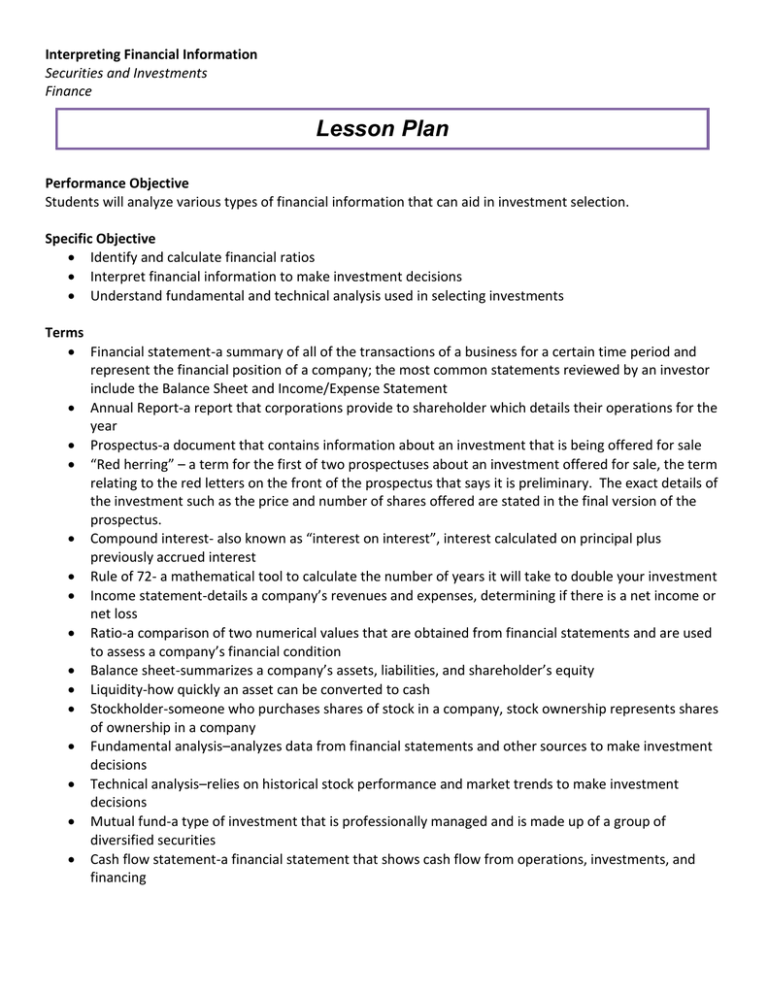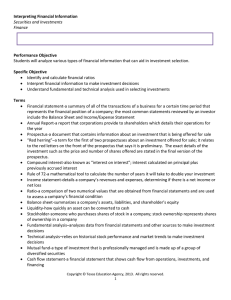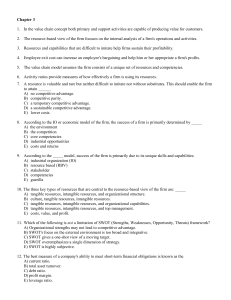Lesson Plan
advertisement

Interpreting Financial Information Securities and Investments Finance Lesson Plan Performance Objective Students will analyze various types of financial information that can aid in investment selection. Specific Objective Identify and calculate financial ratios Interpret financial information to make investment decisions Understand fundamental and technical analysis used in selecting investments Terms Financial statement-a summary of all of the transactions of a business for a certain time period and represent the financial position of a company; the most common statements reviewed by an investor include the Balance Sheet and Income/Expense Statement Annual Report-a report that corporations provide to shareholder which details their operations for the year Prospectus-a document that contains information about an investment that is being offered for sale “Red herring” – a term for the first of two prospectuses about an investment offered for sale, the term relating to the red letters on the front of the prospectus that says it is preliminary. The exact details of the investment such as the price and number of shares offered are stated in the final version of the prospectus. Compound interest- also known as “interest on interest”, interest calculated on principal plus previously accrued interest Rule of 72- a mathematical tool to calculate the number of years it will take to double your investment Income statement-details a company’s revenues and expenses, determining if there is a net income or net loss Ratio-a comparison of two numerical values that are obtained from financial statements and are used to assess a company’s financial condition Balance sheet-summarizes a company’s assets, liabilities, and shareholder’s equity Liquidity-how quickly an asset can be converted to cash Stockholder-someone who purchases shares of stock in a company, stock ownership represents shares of ownership in a company Fundamental analysis–analyzes data from financial statements and other sources to make investment decisions Technical analysis–relies on historical stock performance and market trends to make investment decisions Mutual fund-a type of investment that is professionally managed and is made up of a group of diversified securities Cash flow statement-a financial statement that shows cash flow from operations, investments, and financing Time When taught as written, this lesson should take approximately 4-5 class periods to complete. Preparation TEKS Correlations: This lesson, as published, correlates to the following TEKS. Any changes/alterations to the activities may result in the elimination of any or all of the TEKS listed. 130.164 (c) Knowledge and Skills (2) The student maintains, monitors, controls and plans the use of financial resources in order to perform key duties in the securities and investments industry. The student describes investment analysis and selection processes. The student is expected to: (B) consider the nature of investment risk; (E) relate information that can be obtained from financial statements and annual reports; and (F) communicate the nature of a mutual fund prospectus. (3) The student selects investments for clients. The student is expected to: (A) interpret financial ratios significant to investors. Interdisciplinary Correlations: English-English I 110.31(b)(21)(B). …organize information gathered from multiple sources to create a variety of graphics and forms. 110.31(b)(22)(B). …evaluate the relevance of information to the topic and determine the reliability, validity, and accuracy of sources (including Internet sources) by examining their authority and objectivity. 110.31(b)(23)(C) …use graphics and illustrations to help explain concepts where appropriate. 110.31(b)(23)(D) …uses a variety of evaluative tools (e.g., self-made rubrics, peer reviews, teacher and expert evaluations, to examine the quality of the research. Math-Algebra I 111.32(b)(1)(E). Interpret and make decisions, predictions, and critical judgments from functional relationships. Social Studies-World Geography 113.34(c)(20)(A) Describe the impact of new technologies, new markets, and revised perceptions of resources. Occupational Correlation (O*Net – www.onetonline.org/): Job Title: Financial Analysts O*Net Number: 13-2051.00 Reported Job Titles: Securities Analyst, Investment Analyst, Operational Risk Analyst Tasks: Inform investment decisions by analyzing financial information to forecast business, industry, or economic conditions Recommend investments and investment timing to companies, investment firm staff, or the public Prepare plans of action for investment, using financial analyses Soft Skills: Complex Problem Solving, Judgment and Decision Making, Critical Thinking Accommodations for Learning Differences It is important that lessons accommodate the needs of every learner. These lessons may be modified to accommodate your students with learning differences by referring to the files found on the Special Populations page of this website. Preparation Preparation Have materials and websites ready to go prior to the start of the lesson. Practice locating company annual reports which include a Balance Sheet, Income Statement, and Cash Flow Statement so you can direct students to follow along. You might use a search engine that has a separate Finance link so you know the format of the statements will be similar for all of the corporations examined. References Century 21 Accounting for Texas, General Journal http://fefe.arizona.edu – Family Economics and Financial Education https://kwhs.wharton.upenn.edu/lesson_plans/swot-strengths-weaknesses-opportunities-threats/ Knowledge at Wharton High School (requires free registration to view lesson plans) Instructional Aids Lesson Presentation Instructor Computer/Projection Unit Online Websites Introduction The main purposes of this lesson are to help students understand that there are many different financial methods that investors can look at to make decisions on where to put their money. that there are resources available that can provide information to aid investors. Ask students if they have heard of financial statements such as a balance sheet, income statement, or a cash flow statement. Ask students if they think that work should be done by an investor to determine the most profitable investments possible or if they should let a professional take that responsibility. Outline I. The Annual Report A. Letter to shareholders B. Financial highlights C. Charts and graphics D. Financial statements E. Additional notes F. Company information II. The Balance Sheet A. Assets (Property)-current (cash) and long-term (land, buildings) B. Liabilities (Loans)-current (accounts payable) and long-term (notes payable) C. Net worth, or stockholder’s equity III. The Income Statement A. Revenue-income from sales B. Expenses-operating expenses such as salaries, rent, and utilities C. Net income or net loss-revenue minus expenses IV. The Cash Flow Statement A. Cash flow from operationshopefully a positive number B. Investments-a negative number means company is spending money on investments C. Financing section-a negative number can be because the company is paying dividends or buying shares from investors Annual reports for any company can provide a great deal of information about the financial condition of the company. Search onine for a finance web site to locate an annual report for a company with which they are familiar. Show them the different sections. As you arrive at the balance sheet, point out the items at the left (which are also in the presentation) so they can observe the different terms that are used. Show them the bottom line, or net worth amount. Do the same for the income statement and ask students to volunteer the different amounts so you can be sure that they are finding the same numbers that you are. Again, show the students the different items listed in this outline. Ask them what a negative cash flow can mean for a company, and as a result, what it can mean for an investor. Multiple Intelligences Guide Existentialist Interpersonal Intrapersonal Kinesthetic/ Bodily Logical/ Mathematical Musical/Rhythmic Naturalist Verbal/Linguistic Visual/Spatial V. An Overall Look at Financial Statements A. Has balance sheet improved over the years? B. Net income or net loss? C. Positive or negative cash flow? D. Has cash flow from operations been increasing? E. Any risk factors or legal actions (in annual report)? F. Have gross margins been increasing? G. Calculate various ratios from data in annual reports. VI. What is a Prospectus? A. Information provided by a corporation about an investment offering B. Look for: 1. management fees 2. past performance 3. risks 4. price per share VII. Fundamental Analysis A. Uses data from financial statements B. Uses credit rating of bond issuers C. Looks at interest rates and economic factors D. Type of analysis used by Warren Buffett VIII. Technical Analysis A. Relies on historical performance of a stock to predict future success B. Relies on market trends C. Supply and demand-important factors Financial statements usually show a comparison of two or three time periods. One thing to consider then is whether or not there are patterns, where certain amounts are increasing or decreasing over time. A prospectus provides information about mutual funds as annual reports provide information about individual companies. There are prospectuses for companies as well, but in this lesson we are focusing on the mutual fund prospectus. Search online for a prospectus that you can show students. Use “mutual fund prospectuses” as the search criteria. Fundamental analysis is term for using financial data to make investment decisions. Warren Buffett is a fan of this analysis. You can have students conduct research on Warren Buffett’s style as well as some other wellknown investors. Technical analysis is not as popular a technique. It mainly uses historical Multiple Intelligences Guide Existentialist Interpersonal Intrapersonal Kinesthetic/ Bodily Logical/ Mathematical Musical/Rhythmic Naturalist Verbal/Linguistic Visual/Spatial IX. Financial Ratios-Liquidity A. How quickly assets can be converted to cash B. Current Ratio C. Quick Ratio performance of primarily that particular stock. X. Financial Ratios-Profitability A. Shows how well a company’s assets and equity can generate profits B. Return on Assets C. Return on Equity XI. Financial Ratios-Debt A. Shows how much a company owes to others B. Debt Ratio C. Debt-to-Equity Ratio Return to an annual report of a company that the students suggest. Calculate some of the ratios at the left using the formulas found in the presentation slides and have students follow along, writing down the calculations as you go so they will be able to perform calculations on their own or in pairs. XII. Financial Ratios-Operating and Cash Flow A. Shows how well a company’s assets can generate sales or revenue B. Fixed Asset Turnover Rate C. Operating Cash Flow/Sales XIII. Financial Ratios-Value of Investment A. These depend upon what type of stock investors are looking for B. Price/Earnings C. Dividend Yield D. Price/Book Value Multiple Intelligences Guide Existentialist Interpersonal Intrapersonal Kinesthetic/ Bodily Logical/ Mathematical Musical/Rhythmic Naturalist Verbal/Linguistic Visual/Spatial Application Guided Practice Have students in pairs decide upon a company for which they can go online and locate an annual report. Have them select a ratio that they will calculate for that company. Each pair will post flipchart paper around the room displaying their company, the name of the ratio they used, and the calculation. Also, they will include a recommendation of whether that calculation would result in a positive or negative recommendation to purchase stock in that company. Model for students how to search for and locate an annual report and numbers to use to calculate ratios and have them follow along with you. Independent Practice The teacher can print off some financial statements to be distributed to students. Students should individually circle or highlight accounts that are used in the common ratios found in the presentation to familiarize themselves with the places to look for information. Students can write down each ratio on index cards to keep handy for further practice. Summary Review The following questions can be asked formally, through class discussion, or through the use of exit tickets over several class periods. Question #1: What is the part of an annual report that is most beneficial to investors? Answer #1: The financial statement section. Question #2: What are three financial statements? Answer #2: The balance sheet, the income statement, and the cash flow statement. Question #3: What can the balance sheet show? Answer #3: It can show the amount of debt a company owes to suppliers or other creditors. Question #4: What is important about the income statement? Answer #4: It shows whether a company’s revenues are higher or lower than its expenses. Question #5: Why are ratios important in investment analysis? Answer #5: Ratios can indicate different areas of strength or weaknesses in a company’s financial condition. Evaluation Informal Assessment Any and all of the following can be used as informal assessments… S & I Bingo #2 – You may hand out the bingo card found later in this lesson and have students copy the words from the board or document camera. You may also need a free space for this lesson. Pair-share : teacher should write or type two each of company names to be distributed randomly to students. Each company name should also have a ratio name on it as well. After each student calculates that ratio for his/her particular company, each student will look for the other student who has the same company and ratio. That way they can compare their calculations and help each other if they got different answers. Formal Assessment Annual Report Analysis Assignment #1 - Students will select two companies and conduct Internet research to locate their annual reports. They are to create a table or diagram comparing at least 5 different ratios for the companies using the Balance Sheet, Income Statement, and/or Cash Flow Statements. After this is completed the students should make a recommendation on whether or not investing in stock in these companies would be a profitable idea. Mutual Fund Venn Diagram Assignment #2 – Create a diagram comparing and contrasting 3 different mutual funds by searching online for ‘mutual fund prospectuses’. The outer circles will contain the name of the fund and the price per share of the fund. Other information that should be included are : a statement summarizing past performance of the fund, the risks of the fund, the management fees, and the investing strategy of the fund. These may be included in the outer circles as well, but any information that is common to all three funds should be placed in the overlapping parts of the circles in the Venn diagram. Company SWOT Analysis Assignment #3 – Following the example of the SWOT analysis done as a class, select a company (the teacher can randomly place company names under each chair in the room and the students can see which company name is under their chair) to conduct a SWOT analysis for, as an alternative investment strategy. This analysis may be done on a computer using any of the available templates online or manually on posterboard or flipchart paper. Student should also include an investment recommendation based on the SWOT analysis. Enrichment Extension Interview two people from different generations regarding their personal investment strategies. Create a list of questions including topics of 1) did they use an investment advisor?, 2) where did they put their money at different time periods in their lives, 3) how did they feel about the risk of their investments, 4) if they had a plan at all, and any other questions they would like to ask. Either create a word processing document with the questions and answers for both individuals, or write a report comparing and contrasting the individuals’ answers. S & I Bingo Interpreting Financial Information Annual Report Comparison Chart Assignment #1 Student Name ______________________ CATEGORY 20 15 8 1 Column Headings The chart has creative column headings that accurately describe the material. The chart has The chart is column headings missing a column that adequately heading. describe the material in the chart. Resources The chart contained at least 5 ratios related to the topic being studied. The chart contained only 4 ratios related to the topic being studied. The chart The chart contained only 3 contained fewer ratios related to than 3 ratios. the topic being studied. Content/Facts Facts were accurate for all events reported on the chart and could have been proven if asked to. Facts were accurate for almost all events reported on the chart and could have been proven if asked to.. Facts were accurate for most (~75%) of the events reported on the chart. Facts were often inaccurate for events reported on the chart. Readability The overall appearance of the chart is pleasing and easy to read. The overall appearance of the chart is somewhat pleasing and easy to read. The chart is relatively readable. The chart is difficult to read. The use of font styles and colors is consistent and shows a logical pattern for the most part. It helps organize the material somewhat. The use of font styles and colors is consistent , but is not used effectively to organize. The use of font styles and colors is not consistent OR detracts from the organization. Fonts and Colors The use of font styles and colors is consistent and shows a logical pattern. It helps organize the material. Maximum Points Possible 100 Student Points __________ The chart does not include any column headings or labels of cell data. Interpreting Financial Information Mutual Fund Venn Diagram Assignment #2 Student Name ______________________ CATEGORY 20 15 Labels Each outer circle clearly labeled with name of mutual fund and price per share. Each outer circle Labels missing labeled with from one circle. name of fund but price missing. No labels for 2 or more circles. Required Elements The diagram includes all required elements as well as additional information. All required elements are included on the diagram. All but 1 of the required elements are included on the diagram. Several required elements were missing. Mechanics Capitalization There is 1 error and punctuation in capitalization are correct or punctuation. throughout the diagram. There are 2 errors in capitalization or punctuation. There are more than 2 errors in capitalization or punctuation. Placement of Statements All similar statements are placed in overlapping circles with differences in outer circles. Most statements Few statements Student does not are in the correct are in the correct understand circles. circles. concept of Venn diagrams. Knowledge Gained Student can accurately answer all questions related to facts in the diagram. Student can accurately answer most questions related to facts in the diagram. Maximum Points Possible 100 Student Points __________ 8 Student can accurately answer about 75% of questions related to the diagram. 1 Student appears to have insufficient knowledge about the facts or processes used in the diagram. Interpreting Financial Information Company SWOT Analysis Assignment #3 Student Name ______________________ CATEGORY 20 15 8 1 Strengths/Weaknesses Clearly identifies at least 2 strengths and 2 weaknesses for assigned company. 2 strengths and One strength 2 weaknesses or weakness is identified but missing. are vague. More than one strength and weakness is missing. Opportunities/Threats Clearly identifies at least 2 opportunities and threats for assigned company. 2 opportunities and 2 threats identified but are vague. One opportunity or threat is missing. More than one opportunity or threat is missing. Organization Work is wellorganized and easy to understand. Information is appropriately placed in its respective section. The organization is generally good, but one item may be placed in an incorrect section. The organization is unclear. 2 items placed in an incorrect section. More than 2 items are placed under the wrong section. Grammar There are no grammatical mistakes on the SWOT analysis. There is 1 grammatical mistake on the SWOT analysis. There are 2 grammatical mistakes on the SWOT analysis. There are more than 2 grammatical mistakes on the SWOT analysis. Summary Student includes a thorough summary of recommendation based on analysis. Student includes an adequate summary based on the analysis. Student includes an incomplete summary, somewhat based on the analysis, somewhat based on opinion. Student either included an incomplete summary solely based on opinion, not facts, or did not include one at all. Maximum Points Possible 100 Student Points __________





